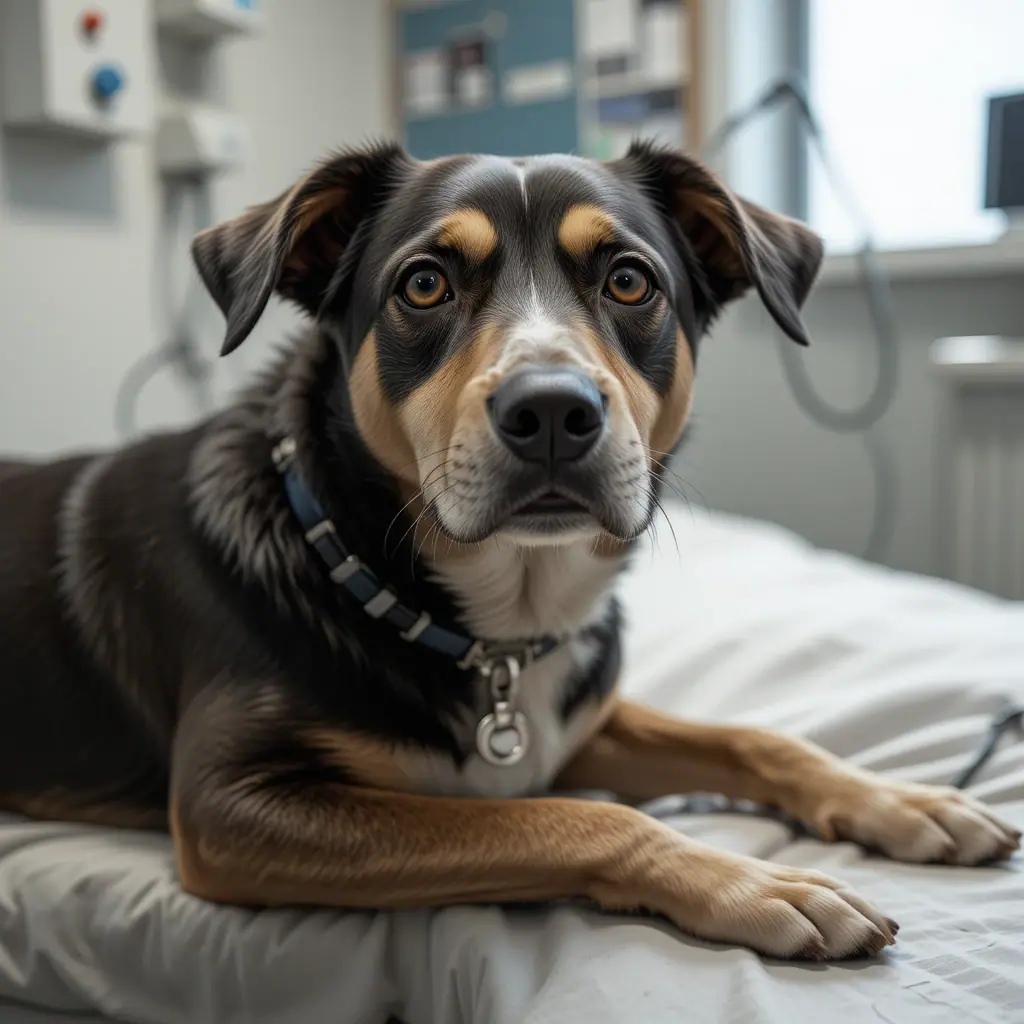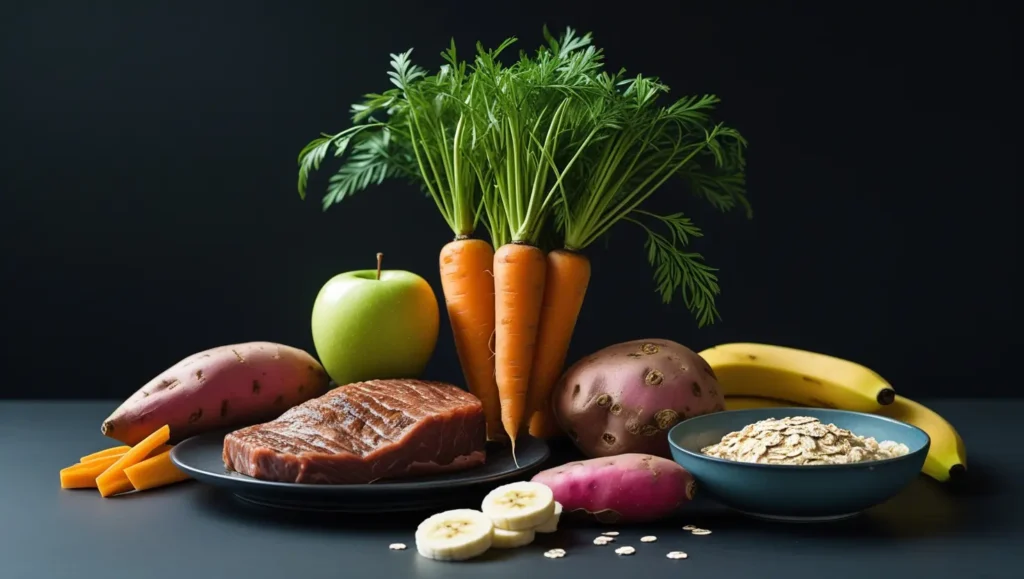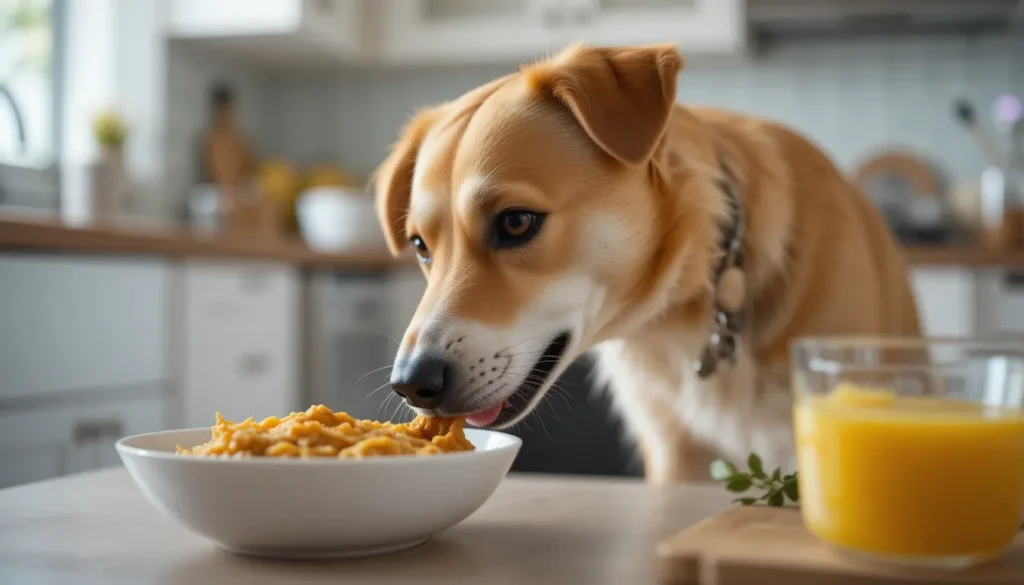Yeast doughor bread cause serious health issues in dogs. When a dog consumes raw yeast dough, the yeast continues to ferment in their stomach. It then produces gas and alcohol.
Why Yeast Dough Is Dangerous for Dogs
Dough Expansion in the Stomach: When yeast dough is ingested, the warm, moist environment of a dog’s stomach provides ideal conditions for the yeast to continue fermenting. As the yeast ferments, it produces carbon dioxide gas. This causes the dough to expand in the stomach.
Gastric Bloating: The expanding dough can lead to gastric dilatation(bloating), which can cause severe abdominal pain and discomfort. In extreme cases, this can progress to gastric dilatation-volvulus (GDV). GDV is a life-threatening condition where the stomach twists on itself, and cuts blood flow.
Alcohol Toxicity from Fermentation: During fermentation, yeast also produces ethanolas a byproduct. This ethanol/alcohol then is absorbed into the bloodstream. It causes alcohol poisoning. Alcohol causes vomiting, disorientation, seizures, and respiratory distress. Severe alcohol poisoning can lead to coma or death if not treated promptly.
Risk of Intestinal Blockage: If the dough forms a large mass in the stomach or intestines, it can cause an intestinal blockage. It prevents food from passing through the digestive tract. This can lead to vomiting, abdominal pain, and constipation. In some situation, this requires surgical intervention to remove the obstruction.
Symptoms of Yeast Dough Poisoning in Dogs
If your dog has consumed yeast dough, they may exhibit the following symptoms:
Early Symptoms
- Abdominal swelling or distension
- Restlessness or pacing
- Unproductive retching
- Pain when the abdomen is touched
Later Symptoms
- Vomiting
- Diarrhea
- Lethargy or weakness
- Disorientation or staggering
- Rapid breathing or difficulty breathing
What Makes Yeast Dough Different from Baked Bread for Dog?
The key difference between yeast dough and baked bread lies in the fermentation process and the state of the yeast. These differences make yeast dough dangerous for dogs, while baked bread is generally safe. Here’s a detailed breakdown:
Active Yeast in Raw Dough: In raw yeast dough, the yeast is alive and active. When the dough is ingested by a dog, the warm, moist environment of their stomach provides ideal conditions for the yeast to continue fermenting. During fermentation, the yeast produces two harmful byproducts- Carbon Dioxide Gas and ethanol. The gas production causes severe abdominal pain, bloating, and stomach twisting (GDV). The alcohol produced during fermentation leads to toxicity.
Deactivated Yeast in Baked Bread: When bread is baked, the high heat kills the yeast. This stops the fermentation process. Baked bread don’t produce gas or alcohol when consumed. The dough also solidifies during baking. So, it does not expand in the stomach.
Since the yeast is deactivated and no longer fermenting, baked bread does not pose the same risks of bloating or alcohol poisoning as raw dough.
Why Is Baked Bread Still Not Ideal for Dogs?
Baked bread is safer than raw yeast dough. Still, it is not a healthy and necessary part of a dog’s diet. Here are some reasons to limit its consumption:
High Carbohydrates: Bread is high in simple carbs. This can contribute to weight gain and obesity if fed regularly.
Low Nutritional Value: Bread offers little to no nutritional benefit for dogs and does not provide essential vitamins, minerals, and protein.
Potential for Digestive Upset: Some dogs may experience gas, bloating, and diarrhea if they eat too much bread.
Additives: Many types of bread contain added sugars, salt, and artificial ingredients that are unhealthy for dogs.
Treatment for Yeast Dough Poisoning in Dogs

If you suspect your dog has ingested yeast dough, do the followings:
Do Not Induce Vomiting Without Guidance: While inducing vomiting may be recommended in some cases of poisoning, it is not safe with yeast dough. If the dough has already started to expand in the stomach, vomiting could cause additional complications. This may cause aspiration (inhaling vomit into the lungs) or worsen the bloating.
Call Your Vet: As soon as you suspect your dog has eaten yeast dough, contact your veterinarianor an emergency animal poison control hotlineimmediately. If you spend unnecessary time, the dough can continue to expand and ferment in the stomach. Provide details. Be prepared to tell your vet:
- The amount of dough consumed.
- The time of ingestion.
- Your dog’s weight and any symptoms they are showing.
Activated Charcoal: Activated charcoal is a substance that can help absorb toxins in the stomach and intestines. It helps to reduce further absorption of alcohol and other harmful byproducts from the fermenting dough. The charcoal binds to the alcohol and other toxins, preventing them from entering the bloodstream. Your vet may administer activated charcoal if the dough was recently ingested and there is still a risk of toxin absorption.
IV Fluids and Supportive Care: Yeast dough poisoning can lead to dehydration, electrolyte imbalances, and alcohol toxicity. IV fluids are essential for:
Flushing Toxins: IV fluids help flush alcohol and other harmful substances from the body.
Maintaining Hydration: Dogs with alcohol poisoning or severe bloating becomes dehydrated due to vomiting and diarrhea.
Correcting Electrolyte Imbalances: Alcohol toxicity disrupts the balance of electrolytes in the body, which IV fluids helps restore.
Your vet may also administer medications to:
- Control seizures (if alcohol poisoning is severe).
- Reduce pain and discomfort from bloating.
- Stabilize heart rate and breathing.
Monitoring for Gastric Dilatation-Volvulus (GDV): Gastric dilatation-volvulus (GDV), commonly known as bloat, occurs when the stomach fills with gas and twists on itself, cutting off blood flow to vital organs. This is a life-threatening emergency that requires immediate surgical intervention.
Symptoms of GDV includes:
- Severe abdominal swelling
- Unproductive retching or attempts to vomit
- Restlessness or pacing.
- Pale gums, rapid heartbeat, and collapse (in advanced cases).
If GDV is suspected, your dog will need immediate surgery to untwist the stomach and remove any damaged tissue. During surgery, the vet may perform a procedure called gastropexy, where the stomach is permanently attached to the abdominal wall to prevent future episodes of GDV.
Surgery for Intestinal Blockage: In some cases, the yeast dough can form a large mass in the stomach and intestines. It causes an intestinal blockage. This prevents food from passing through the digestive tract and leads to vomiting, abdominal pain, and constipation. Some common symptoms of blockage are:
- Vomiting (often projectile)
- Loss of appetite
- Abdominal pain or swelling
- Straining to defecate or inability to pass stool.
If a blockage is confirmed through imaging (X-rays or ultrasound), your dog may require surgery to remove the dough mass and relieve the obstruction.
Monitoring and Hospitalization: Depending on the severity of the poisoning, your dog may need to be hospitalized for several hours or days to monitor. The vet monitors vital signs like heart rate, breathing, temperature. Neurological status is checked for signs of alcohol toxicity, such as disorientation and seizures.
During hospitalization, your dog may receive- Continuous IV fluids, pain management medications, anti-seizure medications (if needed), and antibiotics (if there is a risk of infection from intestinal damage).
Recovery and Follow-Up: Most dogs recover fully from yeast dough poisoning if treated promptly. However, recovery time depends on the severity of the symptoms and whether complications like GDV and blockage occurred. After treatment, your vet may recommend a bland diet (e.g., boiled chicken and rice) to help settle the stomach. Monitoring for any lingering symptoms, such as lethargy or digestive upset is important. Give a follow-up visit to ensure there are no long-term complications.
Prevention for Yeast Dough Poisoning in Dogs

Preventing yeast dough poisoningin dogs is crucial for the well-being for your furry friend. Fortunately, with proper precautions, you can minimize the risk of your dog coming into contact with raw yeast dough. Here are some key prevention strategies:
Keep Raw Yeast Dough Out of Reach
Dogs may be attracted to the smell of the dough sue to natural instincts. So, always store raw yeast dough in a sealed containeror high cabinetwhere your dog cannot access it.
If you’re letting dough rise, place it in a location that is completely inaccessible to your dog, such as inside a closed oven or a locked pantry.
Dispose of unused dough properly by placing it in a sealed trash bagand taking it out immediately. Dogs are notorious for rummaging through trash, so ensure your garbage has a secure lidand is stored in a place your dog cannot access.
Supervise Your Dog During Baking
If you bake bread or other dough-based goods at home, keep a close eye on your dog during the process. Dogs may be tempted to sneak a bite of the dough while you’re kneading or letting it rise.
Train your dog to respond to commands like “leave it” or “drop it”in case they try to grab something they shouldn’t. This can help prevent accidental ingestion of harmful foods.
Educate Family Members and Guests
Make sure all family members, roommates, and guests know that raw yeast dough is dangerous for dogs. Kids innocently offer food to pets without realizing the risks. Teach them about the dangers of feeding raw dough to dogs.
Avoid Feeding Human Food Containing Raw Dough
Never allow your dog to lick bowls or utensils that have been used for preparing raw dough. Even small amounts of dough residue can pose a risk. Be cautious with other unbaked goods like pizza dough, cinnamon rolls, and pastry dough. These items contain live yeast and can cause the same problems as bread dough.
Use Pet-Safe Alternatives for Treats
Instead of giving your dog raw dough or baked bread, opt for dog-safe treats that are specifically formulated for their dietary needs. There are plenty of healthy, nutritious options available that won’t pose any health risks.
Be Mindful During Holidays and Special Occasions
During holidays baking is common. Be extra vigilant about keeping raw dough away from your dog during Christmas, Easter, and Thanksgiving. Guests may not be aware of the risks and could accidentally leave dough within reach. Be cautious with gifts and leftovers that may contain baked goods. While baked bread is generally safe, large quantities can still upset your dog’s stomach.
Recognize the Signs of Curiosity
If your dog shows interest in food preparation areas or seems particularly drawn to certain smells, take extra precautions to keep hazardous foods out of reach. If your dog is sniffing around the kitchen or trying to get to the dough, redirect their attention with a toy or a safe treat to distract them.
Consider a Secure Kitchen Space
Use baby gates or pet barriers to keep your dog out of the kitchen while you’re baking and preparing food. If your dog is crate-trained, consider placing them in their crate during baking sessions to ensure they stay safe and out of trouble.
Safe Alternatives to Yeast Dough for Dogs
If you’re looking for safe alternatives to yeast doughfor your dog, there are plenty of dog-friendly treats and snacks that can satisfy their chewing and snacking needs without posing any health risks.

Here are some safe alternativesto yeast dough for dogs:
Dog-Specific Chew Toys: Durable rubber toys like KONG toys or Nylabonesare excellent alternatives for dogs who love to chew. These toys are designed to withstand aggressive chewing and can be stuffed with peanut butter and other dog-safe spreads to keep your dog entertained.
Fruits and Vegetables: Carrots are low in calories, high in fiber, and packed with vitamins like beta-carotene. Apples (without seeds or cores) are a sweet, crunchy treat that many dogs love. Blueberries can be a great low-calorie treat for dogs. Cooked sweet potatoes are a healthy, starchy alternative to bread. They’re rich in fiber and vitamins.
Peanut Butter (Xylitol-Free): Peanut butter is a popular treat for dogs. It’s crucial to ensure that it does not contain xylitol. You can spread a small amount of peanut butter inside a KONG toy and on a lick mat to keep your dog entertained.
Plain, Cooked Meats: Plain, cooked chicken and turkey (without bones, skin, and seasoning) is a healthy, protein-rich snack for dogs. Make sure it’s fully cooked to avoid the risk of bacterial contamination. Small pieces of plain, cooked beef and lamb can also be a tasty treat for dogs. Avoid fatty cuts and seasonings like garlic and onion.
Dog-Safe Baked Goods: If you enjoy baking, you can make dog-safe baked goodsusing ingredients like canned pumpkin, oatmeal and bananas. Mashed bananas can be used as a natural sweetener in dog treats.
Commercial Dog Treats: There are countless commercial dog treats available that are specifically formulated to be safe and nutritious for dogs. Look for treats made with natural ingredients and free from artificial additives, preservatives, or harmful fillers.
Cooked Eggs: Cooked eggs (boiled or scrambled, without oil, butter, and seasoning) are a great source of protein and healthy fats for dogs. Eggs can be fed occasionally as a treat or added to your dog’s regular meals for extra nutrition.
Yeast dough is dangerous for dogs for severe symptoms and may require emergency veterinary care. Always keep raw yeast dough out of reach of your dog, and seek immediate veterinary attention if you suspect your dog has ingested it. By being cautious and informed, you can help ensure your dog stays safe and healthy.




